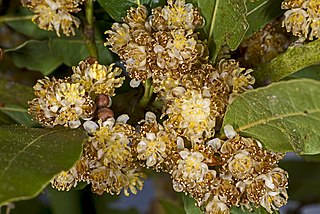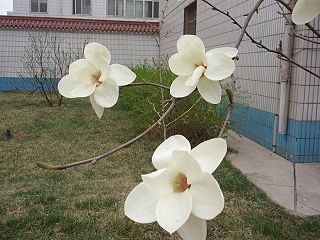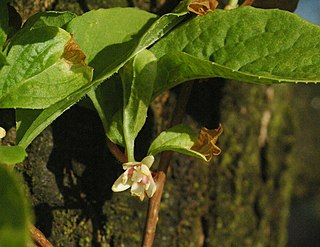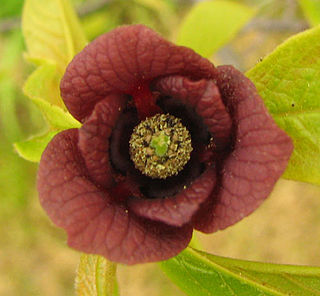
The Laurales are an order of flowering plants. They are magnoliids, related to the Magnoliales.

Magnoliopsida is a valid botanical name for a class of flowering plants. By definition the class will include the family Magnoliaceae, but its circumscription can otherwise vary, being more inclusive or less inclusive depending upon the classification system being discussed.
The Cronquist system is a taxonomic classification system of flowering plants. It was developed by Arthur Cronquist in a series of monographs and texts, including The Evolution and Classification of Flowering Plants and An Integrated System of Classification of Flowering Plants (1981).

Proteales is an order of flowering plants consisting of three families. The Proteales have been recognized by almost all taxonomists.

Illiciales is an order of flowering plants that is not recognized by the current most widely used system of plant classification, the Angiosperm Phylogeny Group's APG III system. The order was comprised differently in various systems of plant taxonomy, but is composed of 2-4 families of shrubs, trees, and lianas native to Australasia, south eastern Asia, and the southeastern United States. The families all contain species with essential oils, and flowers with a perianth with bracts, sepals, and petals incompletely distinguished from each other and not arranged in definite whorls. The families of the order had been variably placed in other orders in different taxonomies.

Austrobaileya is the sole genus consisting of a single species that constitutes the entire flowering plant family Austrobaileyaceae. The species Austrobaileya scandens grows naturally only in the Wet Tropics rainforests of northeastern Queensland, Australia.

Schisandraceae is a family of flowering plants with 3 known genera and a total of 92 known species. Such a family has been recognized by most taxonomists, at least for the past several decades. Before that, the plants concerned were assigned to family Magnoliaceae and Illiciaceae.

Trimeniaceae is a family of flowering plants recognized by most taxonomists, at least for the past several decades. It is a small family of one genus, Trimenia, with eight known species of woody plants, bearing essential oils. The family is subtropical to tropical and found in Southeast Asia, eastern Australia and on several Pacific Islands.

Degeneria is a genus of flowering plants endemic to Fiji. It is the only genus in the family Degeneriaceae. The APG IV system of 2016, recognizes this family, and assigns it to the order Magnoliales in the clade magnoliids.
A system of plant taxonomy, the Thorne system of plant classification was devised by the American botanist Robert F. Thorne (1920–2015) in 1968, and he continued to issue revisions over many years (1968–2007).
One of the modern systems of plant taxonomy, the Dahlgren system was published by monocot specialist Rolf Dahlgren in 1975 and revised in 1977, and 1980. However, he is best known for his two treatises on monocotyledons in 1982 and revised in 1985. His wife Gertrud Dahlgren continued the work after his death.
The APG system of plant classification is the first version of a modern, mostly molecular-based, system of plant taxonomy. Published in 1998 by the Angiosperm Phylogeny Group, it was replaced by the improved APG II in 2003, APG III system in 2009 and APG IV system in 2016.
The Kubitzki system is a system of plant taxonomy devised by Klaus Kubitzki, and is the product of an ongoing survey of vascular plants, entitled The Families and Genera of Vascular Plants, and extending to 15 volumes in 2018. The survey, in the form of an encyclopedia, is important as a comprehensive, multivolume treatment of the vascular plants, with keys to and descriptions of all families and genera, mostly by specialists in those groups. The Kubitzki system served as the basis for classification in Mabberley's Plant-Book, a dictionary of the vascular plants. Mabberley states, in his Introduction on page xi of the 2008 edition, that the Kubitzki system "has remained the standard to which other literature is compared".
A system of plant taxonomy, the Goldberg system was published in:
The Melchior system, "a reference in all taxonomic courses", is a classification system detailing the taxonomic system of the Angiospermae according to A. Engler's Syllabus der Pflanzenfamilien (1964), also known as "modified or updated" Engler system.

Magnoliids are a clade of flowering plants. With more than 10,000 species, including magnolias, nutmeg, bay laurel, cinnamon, avocado, black pepper, tulip tree and many others, it is the third-largest group of angiosperms after the eudicots and monocots. The group is characterized by trimerous flowers, pollen with one pore, and usually branching-veined leaves.

The basal angiosperms are the flowering plants which diverged from the lineage leading to most flowering plants. In particular, the most basal angiosperms were called the ANITA grade, which is made up of Amborella, Nymphaeales and Austrobaileyales.
The APG III system of flowering plant classification is the third version of a modern, mostly molecular-based, system of plant taxonomy being developed by the Angiosperm Phylogeny Group (APG). Published in 2009, it was superseded in 2016 by a further revision, the APG IV system.

The APG IV system of flowering plant classification is the fourth version of a modern, mostly molecular-based, system of plant taxonomy for flowering plants (angiosperms) being developed by the Angiosperm Phylogeny Group (APG). It was published in 2016, seven years after its predecessor the APG III system was published in 2009, and 18 years after the first APG system was published in 1998. In 2009, a linear arrangement of the system was published separately; the APG IV paper includes such an arrangement, cross-referenced to the 2009 one.













